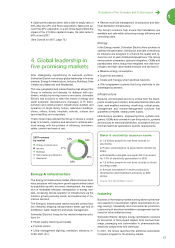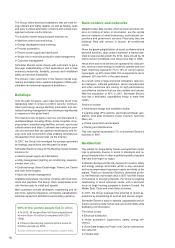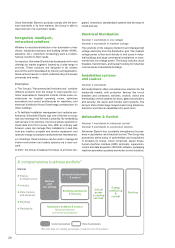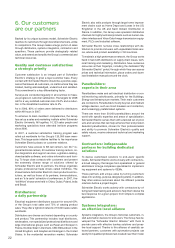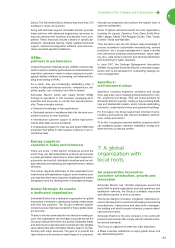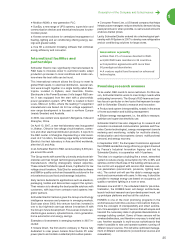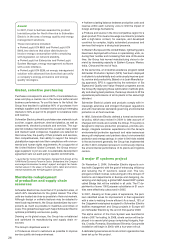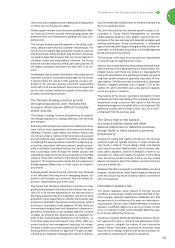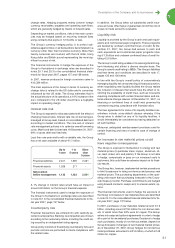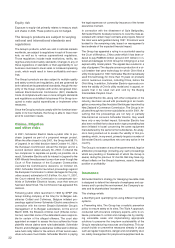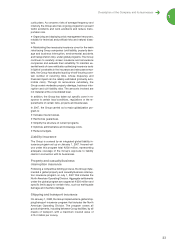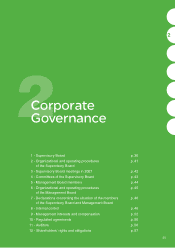APC 2007 Annual Report Download - page 27
Download and view the complete annual report
Please find page 27 of the 2007 APC annual report below. You can navigate through the pages in the report by either clicking on the pages listed below, or by using the keyword search tool below to find specific information within the annual report.
25
Modicon M340, a new generation PLC.
SunEzy, a new range of UPS systems, supervision and
communication devices and electrical enclosures for pho-
tovoltaic power.
Konnex smart solutions for centralized management of
heating, lighting and air conditioning offering energy sav-
ings and greater safety.
Inca 3D a conductor modeling software that combines
energy efficiency and innovation.
International facilities and
partnerships
Schneider Electric has significantly internationalized its
R&D base to innovate closer to customer needs, adapt
production processes to local conditions and locate cen-
ters where the best skills can be found.
This international network allows the Group to meet its
global R&D needs. In electrical distribution, several cen-
ters were brought together in a single facility called Elec-
tropole. Located in Eybens, near Grenoble, France,
Electropole is the Power Business Unit’s largest R&D cen-
ter. It was equipped from the start with a photovoltaic
power generation system. UPS R&D is located in Saint
Louis, Missouri (USA), where the leading IT equipment
manufacturers are based. As for low voltage equipment,
new range development is focused in northern Europe
(mainly Sweden) and Australia.
In 2006, new centers were opened in Bangalore, India and
Shanghai, China.
On April 12, 2007, a new test laboratory was inaugurated
in Jihshan, China for low voltage circuit breakers, contac-
tors and other electrical distribution products. It reports to
the R&D center in Shanghai. Representing a total invest-
ment of 7.6 million, this leading edge facility is Schneider
Electric’s first test laboratory in Asia and third worldwide,
after the US and Asia.
In all, Schneider Electric’s R&D centers employ 6,500 peo-
ple around the world.
The Group works with some fifty university and private lab-
oratories and has forged technological partnerships with
manufacturers offering strategically related expertise.
These include Toshiba for speed drives, Fuji Electric for low
voltage circuit breakers, Tata Elxsi for embedded software
and IBM for quality control and traceability solutions for the
microelectronics and food and beverage industries.
Sixty centers dedicated to applications such as elevators,
packaging, textiles and data centers support this system.
Their mission is to develop the best possible solutions with
customers, with input from contractor and systems inte-
grator partners.
Schneider Electric Ventures gives the Group a technology
intelligence resource and presence in emerging markets.
Each year since 2003, this venture fund has invested in
one to four high-tech start-ups whose innovations fit with
the Group’s future development. Focus areas include nan-
otechnologies, sensors, optoelectronics, micro-generation,
home automation and energy savings.
Examples of investments in emerging markets in 2007 in-
cluded:
Solaire Direct, the first electric company in France fully
dedicated to solar power. Solaire Direct builds PV solar
power plants and installs residential photovoltaic panels.
Consumer Power Line, a US-based company that helps
infrastructure managers reduce electricity demand during
peak periods and, when possible, re-sell unused amounts
at above-market prices.
Lastly, Schneider Electric entered into a technological part-
nership with R-System in 2007 to develop new refrigeration
and air conditioning solutions for large stores.
Promising research avenues
To be useful, R&D needs to serve customers. For this rea-
son, Schneider Electric works to meet today’s needs while
anticipating tomorrow’s. The Group’s R&D teams and cen-
ters focus in particular on two topics that represent a major
shift for Schneider Electric’s research and innovation:
Product and system interoperability, notably in the areas
of home automation and building management.
Efficient energy management, i.e., the ability to measure,
optimize and supervise electricity use.
Schneider Electric has also stepped up its research and
innovation in advanced communication (wireless and Pow-
erline Carrier technologies), energy management (remote
metering and monitoring, notably for multi-site clients),
miniaturization and microsystems (smart, multifunctional
sensors) and energy recovery.
In September 2007, the European Commission approved
the HOMES residential energy efficiency program financed
by France’s Industrial Innovation Agency and led by
Schneider Electric, in cooperation with 14 partners.
The idea is to organize a building like a smart, networked
system to reduce energy consumption by 10% to 30% and
optimize comfort. Each area of the building will have an ac-
tive control unit equipped with sensors that measure vari-
ous parameters (environment, presence, lighting level,
etc.). The control unit will use this data to manage equip-
ment and communicate with users. In this way, it should be
possible to manage energy use based on occupancy, air
quality or ambient lighting in a room or area.
Between now and 2011, the scheduled date for pre-indus-
trialization, the HOMES team will design architectures,
launch technical research and pre-development work, set
up prototype platforms and test all the solutions.
HOMES is one of the most promising programs in the
works because it will drive a series of innovations that pro-
mote the concepts of interoperability and smart automa-
tion. One example is “comfort” sensors that will acquire and
transmit the necessary data on physical characteristics to
manage building comfort. Some of these sensors will be
wireless/batteryless, and therefore very easy to install and
use. Another example is multi-source switchboards that
make it possible to wire and operate systems running off
different power sources. This will allow optimized manage-
ment of different combinations (conventional sources and
renewables).
Innovation: a priority
More than 4% of revenue devoted to R&D.
6,500 R&D team members in 25 countries.
Cooperation agreements with more than
50 prestigious laboratories.
A venture capital fund focused on advanced
technologies.
Description of the Company and its businesses
1




